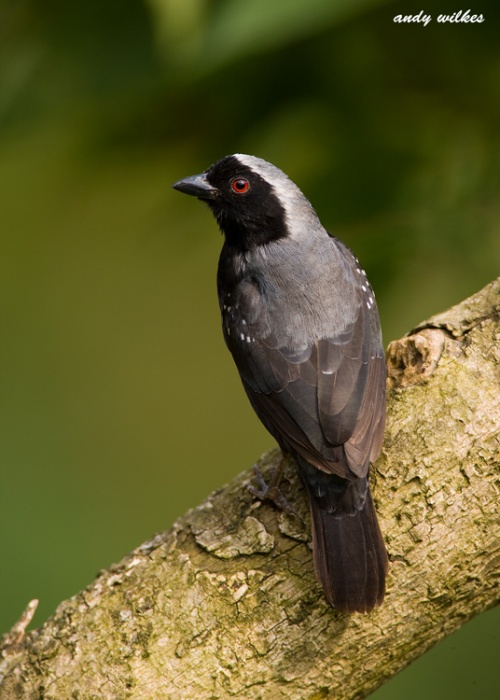(range description, reference updated) |
(id, refs) |
||
| Line 13: | Line 13: | ||
*Black tail | *Black tail | ||
*Red iris | *Red iris | ||
| + | '''Juvenile''' is much more uniform in colors<sup>[[#References|[5]]]</sup> | ||
==Distribution== | ==Distribution== | ||
[[Africa]]:<br /> | [[Africa]]:<br /> | ||
| Line 43: | Line 44: | ||
#Handbook of the Birds of the World Alive (retrieved October 2015) | #Handbook of the Birds of the World Alive (retrieved October 2015) | ||
#BF Member observations | #BF Member observations | ||
| + | #[https://www.birdforum.net/showthread.php?p=3946369 Birdforum thread] discussing a photo of a juvenile of this species | ||
{{ref}} | {{ref}} | ||
Latest revision as of 15:29, 12 January 2020
Alternative name: Grey-headed Negrofinch
- Nigrita canicapillus
Nigrita canicapilla
Identification
13–14 cm (5-5½ in)
- Black forehead and head sides
- Silvery-grey crown, nape and back
- Pale grey rump and uppertail-coverts
- White spots on upper wings
- Black tail
- Red iris
Juvenile is much more uniform in colors[5]
Distribution
Africa:
Western Africa: Guinea, Sierra Leone, Liberia, Ivory Coast, Ghana, Togo, Benin, Nigeria, Cameroon, Central African Republic, Equatorial Guinea, Gabon, Democratic Republic of Congo, Angola, Zaire
Eastern Africa: South Sudan, Kenya, Uganda, Rwanda, Burundi, Tanzania
African Islands: Gulf of Guinea Islands, Bioko
Taxonomy
Subspecies
Nigrita canicapillus has six subspecies:[1]
- N. c. emiliae
- Guinea and Sierra Leone to Ghana and Togo
- N. c. canicapillus
- N. c. angolensis
- N. c. schistaceus
- Extreme southern South Sudan, eastern Democratic Republic of the Congo, Rwanda, Burundi, Uganda, western Kenya, and northwestern Tanzania
- N. c. diabolicus
- N. c. candidus
- Western Tanzania (Kungwe-Mahari Mountains)
Habitat
Clearings, roads, streamsides and edges of both primary and gallery forests. Usually seen in the canopy or mid-level.
Behaviour
A rather solitary bird.
Diet
Ther diet consists of small insects such as ants, termites and larva. Also included are fruits, seed and occasionally nectar.
References
- Clements, J. F., T. S. Schulenberg, M. J. Iliff, D. Roberson, T. A. Fredericks, B. L. Sullivan, and C. L. Wood. 2017. The eBird/Clements checklist of birds of the world: v2017, with updates to August 2017. Downloaded from http://www.birds.cornell.edu/clementschecklist/download/
- Avibase
- Handbook of the Birds of the World Alive (retrieved October 2015)
- BF Member observations
- Birdforum thread discussing a photo of a juvenile of this species
Recommended Citation
- BirdForum Opus contributors. (2024) Grey-headed Nigrita. In: BirdForum, the forum for wild birds and birding. Retrieved 31 October 2024 from https://www.birdforum.net/opus/Grey-headed_Nigrita




